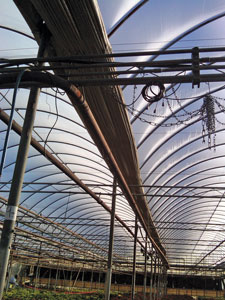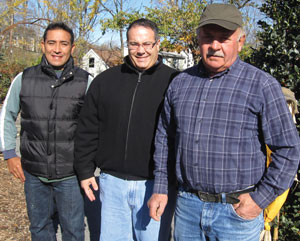11/24/2010
Money-Saving Ideas
Pam Buddy-D’Ambrosio


In an effort to reduce unnecessary costs, heavy equipment manufacturer Caterpillar, Inc. teamed up with Waste Management to initiate cost-saving recycling measures in their 4 million sq. ft. facility in Aurora, Illinois. Caterpillar recycles the gloves from the assembly line workers, as well as scrap metals, concrete, cardboard, plastic, paper, sludge, light bulbs and more. After three months of assembly line recycling, Caterpillar cut 200 tons of trash from the waste stream—a 49% reduction—and saved $200,000 a year in disposal fees.
Smart growers and retailers are looking around their businesses, tracking down and eliminating waste, streamlining procedures, working with vendors for more appropriate services, bringing work in-house, and finding other ways to save. A dollar here, a dollar there … pretty soon you’re talking real money!
Small savings add up
Jay Schrock, owner of Heinz Brothers Greenhouse Garden Center in St. Charles, Illinois, has taken action when it comes to savings. “With expenses,” he says, “it’s hard to hit a home run with everything, but we do the things that are feasible.”
- By switching phone carriers, Heinz Brothers cut $500 a year from their phone bill.
- Through ACH (Automated Clearing House), they established automatic credit card payments that save on check writing and postage.
- They consulted with their trash collectors about ways to reduce their garbage bill. It was suggested they go from weekly to twice-monthly pickups, which has saved $800 to $900 a year. Also, instead of throwing away old trays and pots, which took up space in the Dumpster, they’re returned to the growers for recycling.
- By taking advantage of early pay discounts from vendors, “we save from $7,000 to $10,000 a year,” Jay says.
- They use a reward credit card that offers cash back to pay for business purchases.
- They replaced their large accounting firm with a smaller one, for savings of 30% a year.
- They adjusted store hours: during the summer, the garden center now closes at 7 p.m. instead of 6 p.m. In January and February, they saw a 20% savings on utilities by reducing the work week from five days to four.
Thinking big picture
Bill Swanekamp, co-owner of Kube-Pak, a wholesale grower in Allentown, New Jersey, suggests a few long-term, big-picture ways of saving money that have worked for his family-owned business.
- Use thermal curtains for heat retention as a substantial money saver. “The heat curtains alone save 50% on the heating bill,” he says.
- Necessity was the mother of invention in 1970 when sowing and transplanting were extremely laborious. Bill’s father fashioned an automatic drum seeder before they were available on the market. Now, equipped with two drum seeders and three reciprocating seeders, plus transplanting equipment, daily production has doubled.
- Monitor the labor costs for every production job. Set up the job with the proper number of people in a sufficient amount of time with no stoppages. In New Jersey, growers are allowed to hire crew leaders who are responsible for recruiting, hiring, transporting and paying workers, which amounts to substantial savings for the grower.
- Update or install computer controls for the greenhouses. Instead of a thermostat, use a computer system, which can make more accurate decisions given the status of the greenhouses. “We’ve had the same system since 1986, which was cutting edge at the time and worked well, but it hadn’t been updated,” Bill says. They’ve since switched to Argus controls, which responds much better to changes in the greenhouse environment.
- Use the most energy-efficient boilers available. They’ll pay for themselves over time.
Educate yourself
Mike Lopane of Katonah Nursery in Katonah, New York, took a class on boilers so that he could save money on cleaning and repairs to the system by doing it himself. That’s just one idea he they’ve instituted at their 145-acre (total) business to save on expenses.
- Educate yourself regarding taxes, says Mike. Review all of the taxes of your city, county and state, whether it’s a tax that you’re paying or tax breaks that are available to your industry, like an agricultural tax discount.
- Cover various trades to survive: wholesale, retail and landscaping. Diversification is what sustains their business. In addition to the nursery business, Mike’s father, Joseph Lopane, Sr., invests in properties, then builds and sells houses.
- Heating costs remain lower due to the poly used as thermal curtains, and the reduction of heated greenhouses to only one in the winter.
- Cut back on the work force and hours. As large as the areas are that they cover, the nursery has three laborers, a part-time clerk, two farm workers and six full-time employees. The store closes on Christmas Eve and re-opens in March.
As Joseph says, “Spend less, work hard,” then he reiterated, “Watch your costs, work twice as hard!”
Energy efficiency
Alternative fuel was the direction that Wessels’ Farms, a producer of plugs and unrooted cuttings in Otisville, New York, took when they researched new sources of energy. While the capital expense was $1.2 million, Mike Wessels says they can heat 198,000 sq. ft. of greenhouses and office buildings on a carbon neutral system. Ed Fairweather, vice president of Wessels’ Farms adds, “The big savings is in knowing what your fuel costs are going to be compared to the up and down of #2 oil.”
The equipment they purchased is a multiple fuel combustion boiler that can burn nearly everything from wood to coal, corn, pellets and rubber. Wessels’ Farms receives sawdust bedding with horse manure from a nearby farm, cut-off trees, stumps and wood chips from tree maintenance companies. Tractor-trailers deliver mountains of wood pallets that would otherwise end up in the landfill.
A cyclone apparatus cleans the air of fly ash; the ash that does come from the system is spread on the fields. There’s not much smoke, Mike says, and what is released is 25-32% moisture.
Mike would like to eliminate oil as their fuel and run solely on alternative energy. The system has been on-line for one year and has reduced their oil use from 92,000 to 11,000 gal. He has an immediate goal of reducing to 5,000 gal.
GT
Pam Buddy-D’Ambrosio is a freelance writer based in New Rochelle, New York.